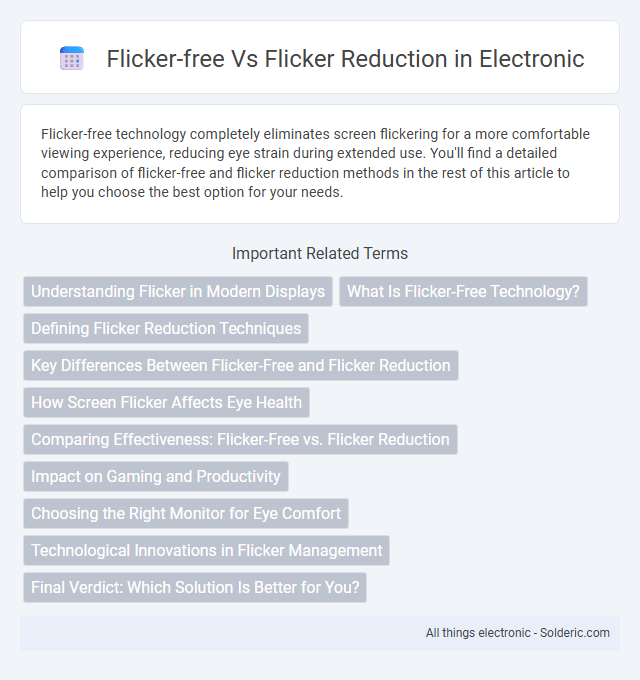Flicker-free technology completely eliminates screen flickering for a more comfortable viewing experience, reducing eye strain during extended use. You'll find a detailed comparison of flicker-free and flicker reduction methods in the rest of this article to help you choose the best option for your needs.
Comparison Table
| Feature | Flicker-Free | Flicker Reduction |
|---|---|---|
| Definition | Eliminates screen flicker completely | Minimizes flicker but may not remove it entirely |
| Technology | DC (Direct Current) backlight dimming | PWM (Pulse Width Modulation) at higher frequency |
| Eye Strain | Significantly reduces eye fatigue and headaches | Reduces eye strain compared to standard flicker |
| Use Case | Best for long screen time and sensitive users | Suitable for general use with moderate flicker issues |
| Cost Impact | Typically more expensive to implement | More cost-effective than full flicker elimination |
Understanding Flicker in Modern Displays
Flicker-free technology eliminates screen flickering by maintaining consistent backlight brightness, improving eye comfort during prolonged use. Flicker reduction techniques minimize flicker intensity through pulse-width modulation adjustments but may not fully eradicate it, potentially causing eye strain. Understanding the difference is crucial for choosing displays with effective flicker management for sensitive viewers or extended screen time.
What Is Flicker-Free Technology?
Flicker-free technology eliminates screen flickering by stabilizing the backlight brightness, which reduces eye strain and fatigue during prolonged device use. Unlike flicker reduction methods that may only minimize flicker at certain brightness levels, flicker-free solutions ensure a consistent, flickerless display experience across all brightness settings. This technology is widely implemented in monitors, laptops, and smartphones to enhance visual comfort and protect users from digital eye strain.
Defining Flicker Reduction Techniques
Flicker reduction techniques involve methods such as DC dimming, high-frequency PWM, and hybrid driving that minimize visible screen flicker to reduce eye strain. Flicker-free technology eliminates flicker by maintaining constant current to the display, whereas flicker reduction lowers flicker intensity without fully removing it. Understanding these differences helps you choose displays that protect your visual comfort during extended use.
Key Differences Between Flicker-Free and Flicker Reduction
Flicker-free technology eliminates screen flicker entirely by using direct current (DC) dimming, providing consistent brightness and reducing eye strain significantly. Flicker reduction, on the other hand, minimizes flicker by adjusting pulse-width modulation (PWM) frequencies but may not completely eradicate flicker, which can still cause discomfort during prolonged use. The key difference lies in flicker-free's complete flicker elimination versus flicker reduction's partial flicker suppression through frequency modulation.
How Screen Flicker Affects Eye Health
Screen flicker, caused by rapid changes in brightness, can lead to eye strain, headaches, and visual fatigue, impacting your overall eye health. Flicker-free technology eliminates these fluctuations entirely, providing a stable light source that reduces strain during extended screen use. Flicker reduction methods minimize flicker frequency but may not fully prevent discomfort, making flicker-free screens a better choice for protecting your eyes.
Comparing Effectiveness: Flicker-Free vs. Flicker Reduction
Flicker-free technology eliminates screen flicker entirely by maintaining a consistent backlight, significantly reducing eye strain and headaches during prolonged use. Flicker reduction methods, often involving pulse-width modulation (PWM) adjustments, lower flicker frequency but may still cause residual flicker perceptible to sensitive users. Studies show true flicker-free displays offer superior comfort and visual stability compared to flicker reduction techniques, making them more effective for extended viewing sessions.
Impact on Gaming and Productivity
Flicker-free technology eliminates screen flicker entirely, reducing eye strain and enhancing comfort during prolonged gaming and productivity sessions. Flicker reduction techniques minimize flicker frequency but may not fully prevent fatigue from extended use, impacting focus and performance. Gamers and professionals benefit more from flicker-free displays for sustained visual clarity and reduced headaches.
Choosing the Right Monitor for Eye Comfort
Flicker-free monitors eliminate screen flickering by using DC (direct current) backlighting, providing a stable and consistent light source that significantly reduces eye strain and fatigue during prolonged use. Flicker reduction technology minimizes screen flicker through advanced PWM (pulse-width modulation) dimming techniques but may still cause subtle flicker perceivable by sensitive users. Choosing the right monitor with true flicker-free technology ensures optimal eye comfort and helps protect Your vision during extended screen sessions.
Technological Innovations in Flicker Management
Flicker-free technology eliminates screen flicker at the hardware level by using DC (direct current) modulation, providing consistent and stable brightness without visible fluctuations, which is crucial for reducing eye strain during prolonged use. Flicker reduction methods typically employ software-based techniques like PWM (pulse-width modulation) frequency adjustments to minimize flicker, but may not completely eradicate it. Your choice between flicker-free and flicker reduction technologies impacts eye comfort significantly, especially in devices like monitors, TVs, and smartphones equipped with advanced flicker management innovations.
Final Verdict: Which Solution Is Better for You?
Flicker-free technology eliminates screen flicker entirely by maintaining a constant backlight, reducing eye strain and fatigue during extended use. Flicker reduction minimizes flickering by adjusting brightness at higher frequencies, offering partial relief but potentially causing subtle discomfort for sensitive users. Your choice depends on sensitivity levels and usage duration, with flicker-free solutions generally providing superior comfort for long-term viewing.
Flicker-free vs Flicker reduction Infographic

 solderic.com
solderic.com